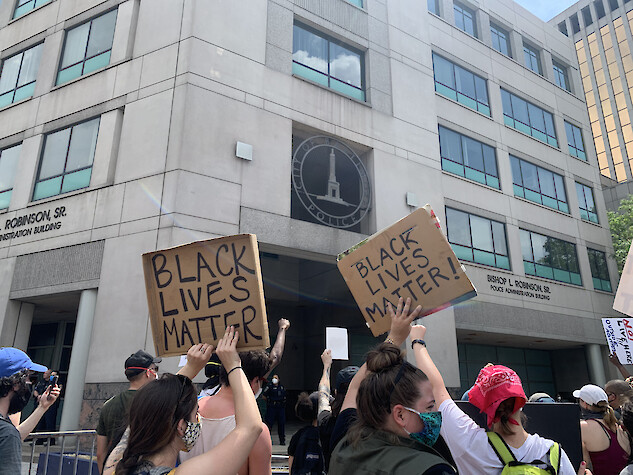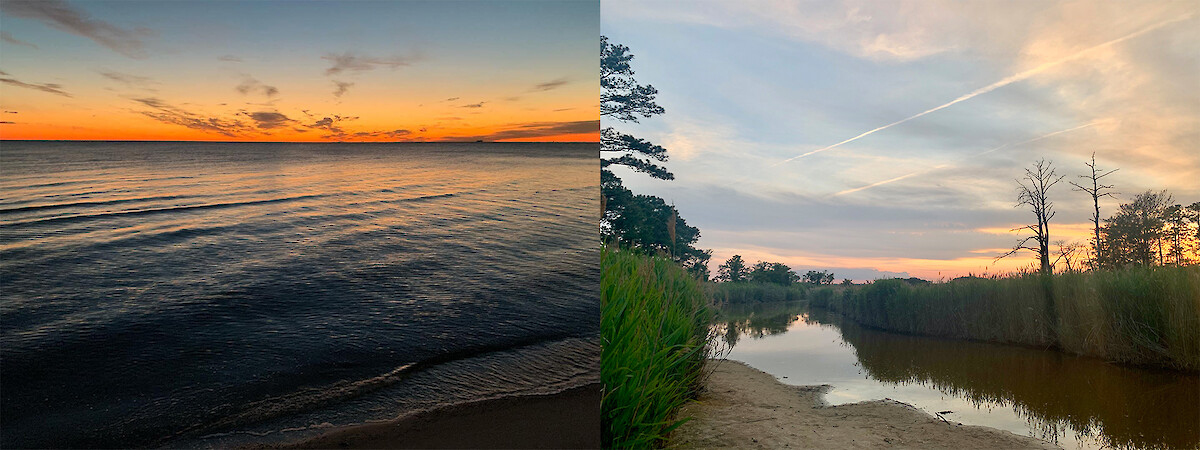Black Lives (And Environmental Journalism) Matter
Andrea Miralles-Barboza ·
This week on our journey to co-produce an Environmental Justice (EJ) Index for the Chesapeake Bay, we were able to meet and talk with Chesapeake Bay journalist Rona Kobell.
Rona, a writer and explorer of all topics Chesapeake Bay, has always had a passion for writing about the bay, its people, and all the things that happen when those two intersect. In more recent years, she found herself writing about Environmental Justice topics that occur in the Chesapeake Bay region, seeking to fill a gap she saw in journalism and hoping to bring awareness not just to the issues that exist in this area but of opportunities for justice moving forward.

During her presentation she shared some statistics with the class:
- The Chesapeake Bay watershed is home to ~18 million people
- Communities of color make up about 35% of the region's population
- People of color make up less than 10 % of those who make rules and regulations for the bay
- Communities of color in the Chesapeake Bay watershed have more health issues related to environmental issues and have less access to healthy environmental spaces
- The main journal that covers the Chesapeake Bay region has an all-white staff
The story told by these statistics is that even though communities of color represent a significant portion of the Chesapeake Bay population, they are impacted by bay management and protection policies that do not represent them in the decision-making processes; additionally, communities of color face institutional hurdles to sharing their thoughts and their voices. The result of this is policies and news stories that serve some, yet silence others. Stories of crabs, sailing, and birds are often told, and stories that point out issues of equity tend to get left behind.
Journalists like Rona point out that Chesapeake Bay journalism, a tool that should share the stories of all and drive change, needs to do better. So how can this be accomplished?
Cue The Environmental Journal Justice Initiative. This initiative was started by Rona and her colleague Donzell Brown Jr. as an effort to empower young voices within communities of color to develop skills in the field of environmental journalism, which, like many other environmental careers, is predominantly a white space that tells mostly white stories. The initiative is also meant to serve as a tool for those not typically represented in Chesapeake Bay reporting to share their own stories.

As I was writing this blog, I realized that I know of and follow very few Black, Indigenous, and People of Color (BIPOC) environmental journalists, and realized it was important to change that. Below is a list of writers who cover a wide range of environmental and social topics, including their Twitter profiles that you can follow.
- Talia Buford (@TaliaBuford) is a writer that covers topics of environmental justice in some of her most well-known work that highlights the EPA's historic failure to protect vulnerable communities to environmental hazards.
- Terri Hansen (@TerriHansen) is an indigenous journalist who writes about global climate change, indigenous climate issues, and many things in between.
- Brentin Mock (@brentinmock) is a writer at CityLab where his work focuses broadly on justice, unsurprisingly the topics of environmental justice are oftentimes the subject of his writing. He also reports on the complex intersections of environmental justice and police violence.
- Gelareh Darabi (@GelarehDarabi) is a Canadian-British-Iranian journalist who covers a variety of topics ranging from science, environment, and climate.
- Hans Nich (@hans_nich) is an Indonesian journalist based out of Jakarta where he covers topics ranging from local to global issues of the environment and their connections.
- Justin Worland (@JustinWorland) is a Time writer who covers the topics of climate change, and the intersections of environmental policy, and politics and people. His work shines a light on the disproportionate impacts of climate change on Black Americans.

The Chesapeake Bay watershed is home to a wide range of people, and our policies and journalism must start to reflect this fact so that all (not just some) can enjoy it. I encourage you to also research, follow, and share the journalism of BIPOC communities, bonus points if you can include where to follow them in the comments!
In the spirit of highlighting the voices and successes of young Black professionals in environmental spaces, I wanted to use this blog post to also congratulate two of my peers whose work addresses pressing issues of justice and representation in the environmental field:
- Faith Taylor, a MEES M.S. student based out of the College Park campus, recently accepted a PhD position at the Yale School of the Environment where she will work with one of the world's leading environmental justice researchers, Dr. Dorceta Taylor. Faith is passionate about the intersection of mass incarceration and environmental justice, and her master's thesis work is currently studying how environmental justice is measured through existing tools.
- Imani Black, an incoming MEES M.S. student based out of Horn Point Lab, recently founded Minorities in Aquaculture (MIA). MIA is a nonprofit that seeks to address the absence of women, specifically women of color, in management and leadership roles within the field of aquaculture. Imani is being featured in a variety of publications this week, including in an article on The Fish Site where she discusses what brought her to do this work, the challenges and successes she has experienced, and what the future may hold for her.
References:
Jain-Conti, S. & Cox, B. (2018, February 8). Four Leading Black Reporters on the Changing Climate Beat. Nexus Media News. Retrieved from https://nexusmedianews.com/four-leading-black-reporters-on-the-changing-climate-beat-501ad5b8bb28/?amp=1.
About the author
Andrea Miralles-Barboza

Andrea Miralles-Barboza is a second year master’s student in the University of Maryland’s Marine Estuarine Environmental Sciences program, with a concentration in Environment and Society. She works with Dr. Michael Paolisso to contextualize the coastal climate adaptation of managed retreat to the Lower Eastern Shore. Andrea is also a member of a research team supported by the Maryland Department of Natural Resources that is examining the human dimensions of a marsh restoration technique known as Thin-Layer Placement, a beneficial use of sediment to restore degraded marshland occurring in the same area of the Chesapeake Bay.
Next Post > Facilitating a Great Barrier Reef partnership workshop in Brisbane
Comments
-
Faith Taylor 5 years ago
I LOVE your shouting out of the twitter handles. Twitter is my favorite social media, so I am looking forward to seeing more activist on my TL thanks to you =)
-
Chelsea Richardson 5 years ago
Another good BIPOC environmentalist to follow is @greengirlleah. She is an advocate for intersectional environmentalism. She also has a website where you can find intersectional environmental stories and where she highlights BIPOC and sustainable businesses (https://www.intersectionalenvironmentalist.com/). Thanks for letting us know about other BIPOC environmentalist!
-
Olivia Wolford 5 years ago
This was a great summary of everything covered! The pictures helped tie everything together. Thanks for including the list of BIPOC environmental journalists so we can continue to stay informed.
-
Taylor Gedeon 5 years ago
This line "People of color make up less than 10 % of those who make rules and regulations for the bay"
How did I never know this? How is this not on more people's radars? I'm not going to ask how is this still going on, because we all know the systemic issues in this country/world.
Also CONGRATULATIONS to Faith and Imani!
-
Katrina 5 years ago
Powerful content and beautiful imagery, Andrea! Thank you for sharing this list of BIPOC/BIPOC-focused journalists and for acting on your own self-reflection. The telling of these stories from different vantage-points can create touchpoints and inroads that may not previously have existed for some. EJ work is challenging and ongoing so there's plenty to do. As Faith and Imani (which also means Faith in Yoruba language) are demonstrating, for justice to happen we have to choose an issue and challenge ourselves to take action to transform it. Lead on ladies!
-
Meg Munkacsy 5 years ago
Nicely done, looking forward to adding these Twitter people to my timeline and these stats to my understanding of Bay policy.
-
Isabel Sullivan 5 years ago
I really enjoyed this post! I always enjoy hearing when people identify that they don't know about a particular topic and then look into it. I was also very unaware of BIPOC journalists and I am grateful that you not only brought this to people's attention but also shared information about who is out there to follow and learn about.
-
Peter 5 years ago
This reminds me of the experience of some ethnic minorities. Because they are not interested in political activities, although they have good living conditions, their political status has always been at a disadvantage. For example, even they have ability of pay the bill for nursing, but they are still rejected by hospital as sickbed is prepared for another part of people. There is an old saying ' the child who cry most loudly has more milk to drink'. I hope they can make their own voices for not being forgotten, just like ‘black live matter’.
-
Amber Fandel 5 years ago
Thanks for the list of resources for us to diversify our feeds and perspectives. These stats also make the issue stark- communities of color, who are the most impacted by environmental changes in the Bay, are not being represented. Also, love seeing these inspiring humans highlighted. Congrats Faith and Imani! It is very well-deserved and we all look forward to continuing to learn from and with you.
-
Jehnae 5 years ago
I think a lot of people don't realize the connection between the Black Lives Matter Movement and Environmental Justice. There are so many advocated that we never know about. Thanks for tagging them.
-
Sarah 5 years ago
The future of EJ is in good hands with Faith and Imani B.! I love the fact that you highlighted two students that are in the course who are focusing on the issue of EJ. Two future leaders of EJ who may just be asked to be a stakeholder or guest speaker on environmental justice like the many speakers we have had in the beginning of the semester!
-
Nylah McClain 5 years ago
I learned somewhere along the way that the reason why various places have certain environmental issues is because indigenous environmental justice activists of the past were ignored. Newcomers to an area (colonizers) seem to have a habit of not adapting to the environment and instead try to make the environment apart to them, which causes all of these issues.
-
Ashley Silver 5 years ago
I love how you promote BIPOC in journalism on environmental issues and highlighted two of our fellow classmates on their work on environmental injustices.
-
Imani Wilburn 5 years ago
Wow! Not only did this help remind me of Rona's presentation, but the statistics are given really help to paint a picture of the situation in the Chesapeake Bay when it comes to people of color and their lack of a voice. I love how once you highlighted the lack of a voice that POC has, that you then took the extra step to promote POC who are trying to have a voice and help their communities. I could not think of a better way to try and highlight and slightly tackle the issue. Great job!
-
Shakira 5 years ago
Andrea, Thank you for providing a list of BIPOC environmental journalist. Following this class, I do plan to follow the EJ topic and conversations and this would be a great way to stay informed.

